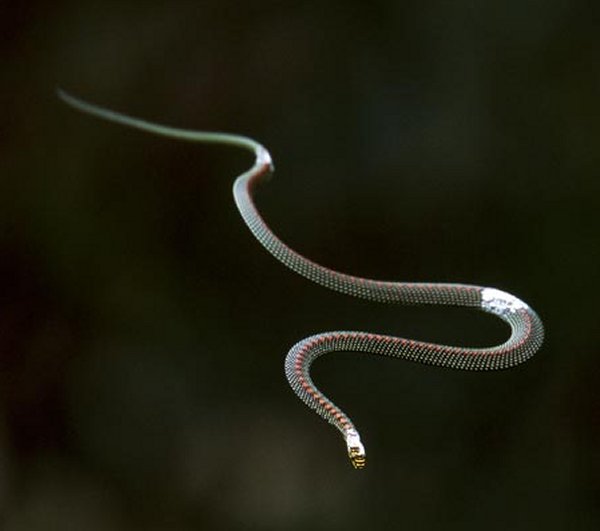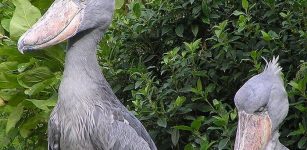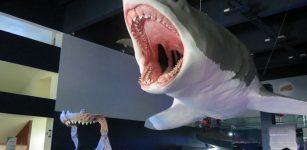Fascinating Study: Deep Secrets Of Flying Snakes Revealed
MessageToEagle.com – Some snakes can fly, according to scientists who may have solved the mystery of how flying snakes stay aloft.
There are five species of paradise tree snakes Chrysopelea paradise. They have intriguing body shape and can be found in the Southeast Asian rainforest.
They have the ability to glide as much as 30m from a tall tree and their ‘slithering’ in an S-shape through the air as they descend is particularly impressive.
‘They look like they are swimming’, but what keeps the reptiles aloft? ‘They turn their whole body into one aerodynamic surface’, explains Professor Jake Socha, from Virginia Tech in the US, who carried out the study.

Socha and his colleagues Daniel Holden, Nicholas Cardwell and Pavlos Vlachos, discovered that the snake’s body works like an aerofoil to generate lift forces to keep them airborne.
The snakes flex their ribs as they launch to stretch and flatten the body to change their profile from a circle into an arched semi-circle, according to Socha.
‘It looks like someone’s version of a UFO’, laughs Socha, adding that as aerofoils go it’s an unconventional shape.
Trying to understand the aerodynamic forces generated by the snake’s body, the team created a plastic copy of the snake’s cross-section and placed it in a tank of flowing water.
Although water is much more dense than air, the experiment recreated the effect of air flowing over a snake’s body.
At most angles, the unusual body shape generated sufficient lift to keep the creature aloft.

However, there is much more to the snake’s impressive glide than just its unusual body shape, Socha adds.
‘If you make a rough estimate of the lift to drag ratio for the real animal, it appears to do better than what we got from this study.”
“So even though this shape produced more lift than we were expecting, it doesn’t get us the glide performance that snakes can attain, giving us a hint that there is something in what the animal is doing aerodynamically that is not captured by the cross-sectional shape alone’ – which is the next part of the problem that Socha and his team hope to crack.
Journal Reference:
Holden, D., Socha, J. J., Cardwell, N. and Vlachos, P. P.(2014). Aerodynamics of the flying snake Chrysopelea paradisi: how a bluff body cross- sectional shape contributes to gliding performance. J. Exp. Biol.217, 382-394 doi:10.1242/jeb.100339
MessageToEagle.com
Related Posts
-
 Rapid Migration Of Dinosaurs Across The Globe May Have Contributed To Their Own Demise
No Comments | Mar 4, 2018
Rapid Migration Of Dinosaurs Across The Globe May Have Contributed To Their Own Demise
No Comments | Mar 4, 2018 -
 Jellyfish Without A Central Brain And Roots Of Learning And Memory – Study
No Comments | Sep 24, 2023
Jellyfish Without A Central Brain And Roots Of Learning And Memory – Study
No Comments | Sep 24, 2023 -
 Visually Stunning Tree Of All Known Life Unveiled Online
No Comments | Dec 15, 2021
Visually Stunning Tree Of All Known Life Unveiled Online
No Comments | Dec 15, 2021 -
 Incredible Giant Shoebill Stork Looks Like A Real Dinosaur
No Comments | Sep 29, 2018
Incredible Giant Shoebill Stork Looks Like A Real Dinosaur
No Comments | Sep 29, 2018 -
 Millions Of Bizarre Luminous Creatures Invade The West Coast In U.S And No-One Knows Why
No Comments | Jun 19, 2017
Millions Of Bizarre Luminous Creatures Invade The West Coast In U.S And No-One Knows Why
No Comments | Jun 19, 2017 -
 10 Fascinating Facts About Plants
No Comments | Aug 2, 2016
10 Fascinating Facts About Plants
No Comments | Aug 2, 2016 -
 Why Microbes In The Deep Ocean Live Without Sunlight – New Study
No Comments | Feb 8, 2023
Why Microbes In The Deep Ocean Live Without Sunlight – New Study
No Comments | Feb 8, 2023 -
 New Research Bites Holes Into Theories About Megalodons
No Comments | Feb 9, 2022
New Research Bites Holes Into Theories About Megalodons
No Comments | Feb 9, 2022 -
 560-Million-Year-Old Fossil Is Earliest Known Animal Predator
No Comments | Jul 28, 2022
560-Million-Year-Old Fossil Is Earliest Known Animal Predator
No Comments | Jul 28, 2022 -
 Cooler Waters Created Super-Sized Megalodon – Study Shows
No Comments | Mar 7, 2022
Cooler Waters Created Super-Sized Megalodon – Study Shows
No Comments | Mar 7, 2022
